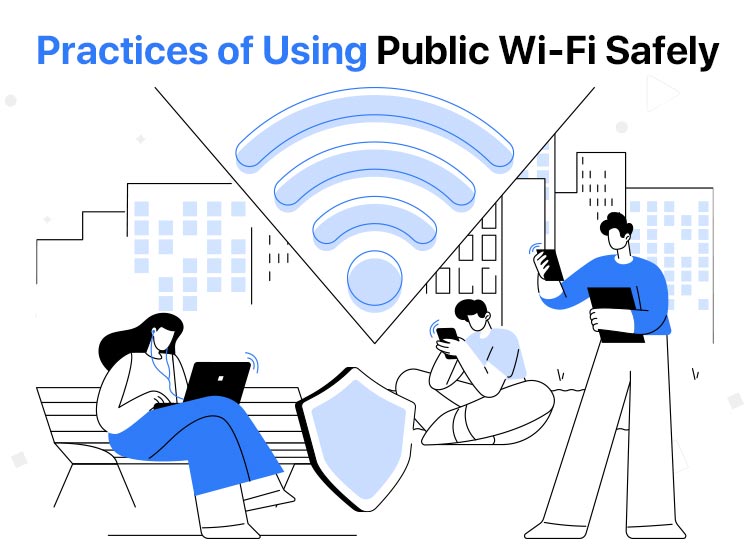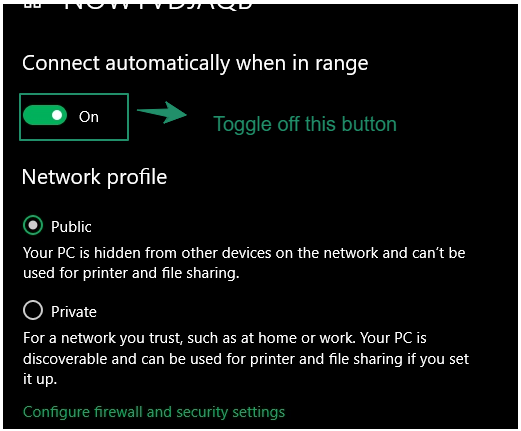
While public Wi-Fi helps you access the internet on the go, it also poses significant security risks. For example, it may expose your system to cyber attacks, data theft, malware infections, and session hijacking (hackers accessing your accounts without passwords). Hence, you must know how to use public Wi-Fi safely.
In this article, we present a comprehensive public Wi-Fi security guide to help you remain safe on public networks. Let us dive right into this guide by first understanding the security risks associated with public Wi-Fi networks.
Public Wi-Fi Security Risks
A public Wi-Fi that lacks strong security measures may endanger your security and expose you to the following risks.
- Cybercriminals on the same network can intercept your online activities (for instance, banking information, personal messages, and login credentials).
- Deceptive networks (rogue access points or malicious hotspots) may trick you into connecting by imitating licit Wi-Fi names, and then later steal your data or attack your system.
- Unsecured public Wi-Fi networks may lead to man-in-the-middle attacks. It is a form of cyberattack where an attacker discreetly places themselves between two parties (for example, you and an app), allowing them to catch, manipulate, or eavesdrop on communications. This may also lead to session hijacking.
- Once connected to an unsecure network, bad actors on the network may exploit your device’s vulnerabilities to install malicious programs, such as spyware or ransomware, without your knowledge.
- You may be a victim of packet sniffing or Wi-Fi snooping. It is a technique where cybercriminals snoop on Wi-Fi signals through particular software tools and devices, allowing them to see what you are doing online—they can see your every online activity, ranging from the web pages you view to the sensitive documents or pictures you send and receive.
The above are the top risks of using public Wi-Fi. Now, since you wonder if it is safe to use a public Wi-Fi network that isn’t password protected, let us look at some common activities you do on a public Wi-Fi to check whether or not it is safe to do them.
Which of the Following Is Safe to Do Over Public Wi-Fi
Below are some general activities that you do while connected to a public Wi-Fi network, and whether or not they are safe.
Browsing publicly accessible websites—Safe if the websites are encrypted
Connecting to an unsecured Wi-Fi network and browsing non-encrypted websites (websites with addresses starting with HTTP) makes your traffic visible to others on the network.
Hence, ensure to browse only websites with an SSL certificate, i.e., encrypted websites starting with “HTTPS” and having a padlock symbol, which hides your traffic to secure your personal information.
Note: In addition to HTTPS in the browser address bar of all the website pages, consider the website/email content, exit the website/do not reply to the email, do not click anywhere if you find the website or email suspicious, and check for wrong domains or misspellings within a link, as the FBI has warned about cybercriminals dishonestly incorporating https in links to make them appear safe when they are not.
Accessing important accounts—Unsafe without strong passwords and two-factor authentication
While accessing your crucial accounts is not generally recommended, as hackers always have an eye on such data, and unsecure Wi-Fi networks serve it to them on an open and tempting plate, you can take the risk in essential situations if you have complex passwords (a mix of uppercase and smallcase letters, special characters, and numbers) that are tough to crack.
Moreover, ensure you have a unique password for each online service to keep other accounts secure if one of your accounts is compromised.
Furthermore, two-factor authentication is recommended for all accounts, as bad actors can intercept your internet traffic on public Wi-Fi, which may result in compromised accounts. When you have two-factor authentication (2FA), snoops cannot access your critical accounts without performing the second step for authentication, for instance, entering a code received on your mobile device. Also, keep in mind to log out of your accounts after you are finished using them.
Online banking—Unsafe, use a VPN/your smartphone’s hotspot in emergencies
Since public Wi-Fi networks often lack the encryption necessary to protect your data, hackers can intercept your banking or financial information, which results in huge losses. Hence, as far as you can, you should avoid online banking when connected to a public network.
However, if you are in an emergency, ensure you use a VPN (Virtual Private Network) that encrypts your internet traffic or the hotspot feature on your smartphone to make it much harder for hackers to access your data.
Also know: How to Fix Wifi Connected But No Internet Connection
Automatically connecting to a network—Unsafe
Many devices, such as laptops) comes with automatic connectivity settings, allowing your device to connect with nearby networks easily. While this is fine with trusted networks, you should turn off auto-connect for public networks to avoid man-in-the-middle attacks, unsecured networks, and malware infections.
To turn off automatic connection on your computer or laptop, you can navigate to settings via the Win+I keyboard shortcut, choose Network & Internet from the available settings, select the option to Manage Known Networks, and then uncheck the Connect automatically when in range option.

Additionally, make sure to check the “forget network” option after using the public Wi-Fi.
Keeping fire sharing on—Unsafe
Keeping the file sharing option enabled exposes your files and folders to anyone on your network, making it easier for hackers to access your private information without your knowledge.
Hence, ensure to turn off file sharing while on a public network. On your computer, you can navigate to the network and sharing center, then change advanced sharing settings, and then turn off file and printer sharing.
Now that you are familiar with what is safe and unsafe on a public Wi-Fi network, let us quickly recap how to secure Wi-Fi.
How to Safely Use Public Wi-Fi
You can follow the best practices below to ensure public Wi-Fi security.
- Confirm the network name and login credentials with the appropriate authority before connecting to a public Wi-Fi network to ensure the network you are connecting to is legitimate.
- Use a VPN to encrypt your data as it passes to and from your device and create a protective tunnel to hide the data from others on the network.
- Turn off auto-connect to keep your system protected from unsecure networks, malware infections, and man-in-the-middle attacks.
- Ensure all websites you visit are encrypted (HTTPS) and are safe to prevent cybercriminals from accessing your information or invading the system.
- Never access banking or other sensitive information on a public Wi-Fi. If you must do so in emergencies, use a VPN or your smartphone’s hotspot.
- Avoid unsecure Wi-Fi networks (Wi-Fi networks that do not require login credentials to connect).
- Keep the firewall enabled. You can enable the firewall on your computer by following the path Control Panel>System and Security>Windows Firewall.
- Have the latest version of antivirus software installed on your computer to protect it from malware attacks.
- Enable two-factor authentication and create complex passwords for all your accounts to keep them secure.
- Patch the security vulnerabilities that hackers can exploit by regularly updating all software installed on your system.
- Use browser extensions to enhance your safety by preventing web-based attacks.
- Do not connect automatically to a Wi-Fi network to reduce the chances of getting deceived by hackers.
- Make it a habit to log out of your accounts when you are done using them and forget the network after the session ends to prevent automatic reconnection.
- Update your operating systems to patch any security loopholes that hackers or cybercriminals can take advantage of.
Also know: Intel WiFi Drivers Download and Install for Windows PC
Complete Guide to Using Public Wi-Fi Safely: The Conclusion
To conclude, while public Wi-Fi is a convenient and cost-effective way to use the internet on the move, it may not be the smartest thing you can do, as it may lead to malware infection, data loss, and cyberattacks.
Hence, this article presented an end-to-end guide to help you safely use public Wi-Fi by implementing some simple tips. We hope you find this information useful.
However, if you have any doubts, questions, feedback, or suggestions about this post, please reach out to us via the comments section.

